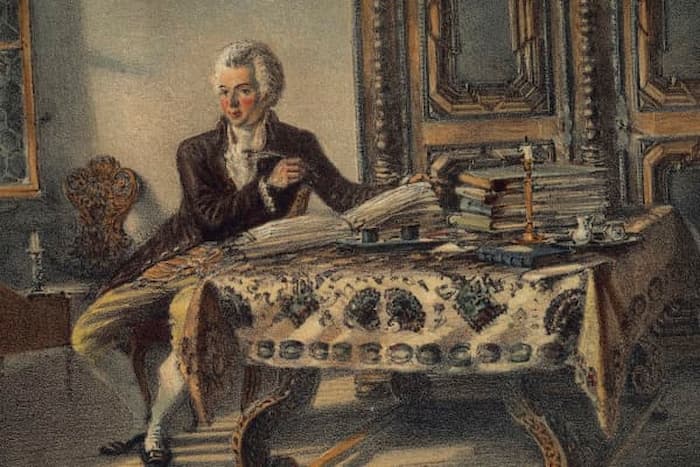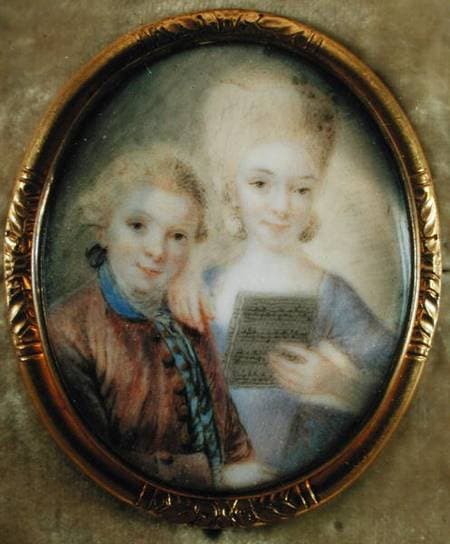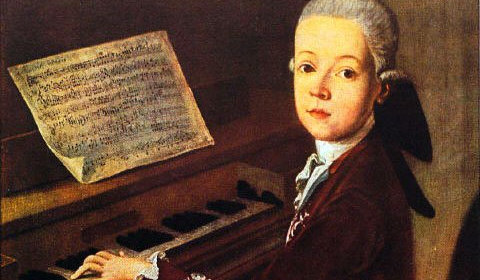Every music lover knows that Mozart was one of the most extraordinary prodigies in the history of music: he began composing when he was only five years old! But have you ever sat down and listened to these early works?

Portrait of Wolfgang Amadeus Mozart © cnbc.com
Today we’re taking a tour of some of Mozart’s earliest works and learning the fascinating stories behind them.
The Köchel Catalogue
Before we get started, we first need to talk about something called the Köchel Catalogue.

Ludwig von Köchel © Wikipedia
Over the course of his life, Mozart wrote hundreds of pieces of music, including symphonies, concertos, sonatas, and more. The opus numbers of those pieces gave an indication of what order they were published in, and as an adult, Mozart did his best to keep records of them himself, but by the time of his death, it became clear that a more thorough classification system was needed.
After Mozart died, it took decades for scholars to come up with a comprehensive catalogue system for his massive output. The first person to do so was an Austrian musicologist by the name of Ludwig von Köchel, who put out his list in 1861. Over the centuries, as new scholarship has emerged, others have refined Köchel’s work. Music lovers use the initial “K” to abbreviate a work’s so-called “Köchel number.” We’ll be using those numbers today instead of opus numbers.
Andante in C-major, K. 1a
Written just after Mozart turned five
It is believed that Mozart’s first surviving composition is this little ten-measure andante for piano, written in early 1761.

Wolfgang and Nannerl Mozart
In 1759, Wolfgang’s father Leopold began a pedagogical notebook for Wolfgang’s prodigiously talented eight-year-old sister Maria Anna Mozart, nicknamed Nannerl. In it Leopold would compose and collect pieces for his daughter – and later his son – to study.
Wolfgang wrote some of his first compositions in Nannerl’s notebook. (Oddly, even though we know she was also a composer, none of the music in Nannerl’s notebook was actually composed by Nannerl.) This little piano piece was apparently composed by Wolfgang, but written out by Leopold.
It may not be the most groundbreaking piece of music ever written, but of course, it’s impressive for a five-year-old…and hey, every composer has to start somewhere!
Klavierstück in C, K. 5a
Written when Mozart was eight
This piece is also in Nannerl’s notebook. Its claim to fame is that it is the first piece actually written out by Wolfgang and not his father.
The musical growth between K. 1a and 5a is immense. Here we have a main theme with vocal qualities, a call and response between hands, two repeat signs, and even some modulations in the second half.
Sonata in C for Keyboard and Violin, K. 6
Written when Mozart was between six and eight

The young Wolfgang Amadeus Mozart
We don’t know exactly when – and therefore where – these first sonatas for keyboard and violin were composed. Some scholars believe the first two were written in the Mozarts’ hometown of Salzburg in 1762 or 1763, while others believe they were written after the family left for Paris in 1763. (By that point, the family had embarked on a tour to show off both Nannerl and Wolfgang’s genius.)
What we do know is that a set of two sonatas for keyboard and violin were published as Wolfgang’s Op. 1 in Paris in February 1764, just weeks after Wolfgang turned eight.
Amusingly, as early as this piece is, Wolfgang was already stealing from himself when he wrote it! The first three of the four total movements are arrangements of pieces that originally appeared as solo keyboard works in Nannerl’s notebook.
Leopold, always chasing after status, had the two violin sonatas in this opus number dedicated to Victoire of France, the fourth daughter of King Louis XV. No word on whether Victoire appreciated the gift!
Symphony No. 1, K. 16
Written when Mozart was eight years old
Between K. 6 and K. 16, young Wolfgang wrote no fewer than ten violin sonatas. It’s clear that he was learning quickly and was ready for a bigger musical project.
He got his chance by accident in the summer of 1764. In June the Mozart’s family travels brought them to London, where the children began performing for the aristocracy. On their way to one performance, Leopold ran alongside a sedan chair that was carrying Nannerl and Wolfgang. The effort, he believed, led to overexertion and a grave illness. It was unclear whether he would survive, and he even pondered who should take over Wolfgang’s education if he would die. (Needless to say, he survived.)
While Leopold was recovering, the children weren’t allowed to practice or make noise. So Wolfgang and Nannerl decided to work on a symphony together, relying on Wolfgang’s inner ear.
Nannerl famously wrote of their collaboration, “In order to occupy himself, Mozart composed his first symphony with all the instruments of the orchestra, especially trumpets and kettledrums. I had to transcribe it as I sat at his side. While he composed and I copied he said to me, ‘Remind me to give the horn something worthwhile to do!’”
It is, as you can imagine, an awfully adorable work!
For more of the best in classical music, sign up for our E-Newsletter




